XIN LIANG AND MARTHA LAM MANDARIN
CHINESE CHARACTERS Language Practice Pad  Published by Tuttle Publishing, an imprint of Periplus Editions (HK) Ltd. www.tuttlepublishing.com Copyright 2017 by Periplus Editions (HK) Ltd All rights reserved. No part of this publication may be reproduced or utilized in any form or by any means, electronic or mechanical, including photocopying, recording, or by any information storage and retrieval system, without prior written permission from the publisher. ISBN 978-0-8048-4649-3; ISBN 978-1-4629-1943-7 (ebook) First edition 20 19 18 17 10 9 8 7 6 5 4 3 2 1 1705CM Printed in China TUTTLE PUBLISHING is a registered trademark of Tuttle Publishing, a division of Periplus Editions (HK) Ltd. Distributed by North America, Latin America & Europe Tuttle Publishing 364 Innovation Drive North Clarendon, VT 05759-9436 U.S.A. Ltd. 61 Tai Seng Avenue #02-12 Singapore 534167 Tel: (65) 6280-1330; Fax: (65) 6280-6290 www.periplus.com ABOUT TUTTLE Books to Span the East and West Our core mission at Tuttle Publishing is to create books which bring people together one page at a time. 61 Tai Seng Avenue #02-12 Singapore 534167 Tel: (65) 6280-1330; Fax: (65) 6280-6290 www.periplus.com ABOUT TUTTLE Books to Span the East and West Our core mission at Tuttle Publishing is to create books which bring people together one page at a time.
Published by Tuttle Publishing, an imprint of Periplus Editions (HK) Ltd. www.tuttlepublishing.com Copyright 2017 by Periplus Editions (HK) Ltd All rights reserved. No part of this publication may be reproduced or utilized in any form or by any means, electronic or mechanical, including photocopying, recording, or by any information storage and retrieval system, without prior written permission from the publisher. ISBN 978-0-8048-4649-3; ISBN 978-1-4629-1943-7 (ebook) First edition 20 19 18 17 10 9 8 7 6 5 4 3 2 1 1705CM Printed in China TUTTLE PUBLISHING is a registered trademark of Tuttle Publishing, a division of Periplus Editions (HK) Ltd. Distributed by North America, Latin America & Europe Tuttle Publishing 364 Innovation Drive North Clarendon, VT 05759-9436 U.S.A. Ltd. 61 Tai Seng Avenue #02-12 Singapore 534167 Tel: (65) 6280-1330; Fax: (65) 6280-6290 www.periplus.com ABOUT TUTTLE Books to Span the East and West Our core mission at Tuttle Publishing is to create books which bring people together one page at a time. 61 Tai Seng Avenue #02-12 Singapore 534167 Tel: (65) 6280-1330; Fax: (65) 6280-6290 www.periplus.com ABOUT TUTTLE Books to Span the East and West Our core mission at Tuttle Publishing is to create books which bring people together one page at a time.
Tuttle was founded in 1832 in the small New England town of Rutland, Vermont (USA). Our fundamental values remain as strong today as they were thento publish best-in-class books informing the English-speaking world about the countries and peoples of Asia. The world has become a smaller place today and Asias economic, cultural and political influence has expanded, yet the need for meaningful dialogue and information about this diverse region has never been greater. Since 1948, Tuttle has been a leader in publishing books on the cultures, arts, cuisines, languages and literatures of Asia. Our authors and photographers have won numerous awards and Tuttle has published thousands of books on subjects ranging from martial arts to paper crafts. We welcome you to explore the wealth of information available on Asia at www.tuttlepublishing.com .
INTRODUCTION How did characters come about? Chinese characters, or Hanzi (), have evolved over 5,000 years. While the earliest characters inscribed on oracle bones (16001046 B.C.) are mostly pictographic (), they only represent about 4% of the total number. The vast majority are pictophonetic characters (), consisting of a meaning and a phonetic component. The other two categories include indicative characters () and associative characters (). Below are examples of the four categories: 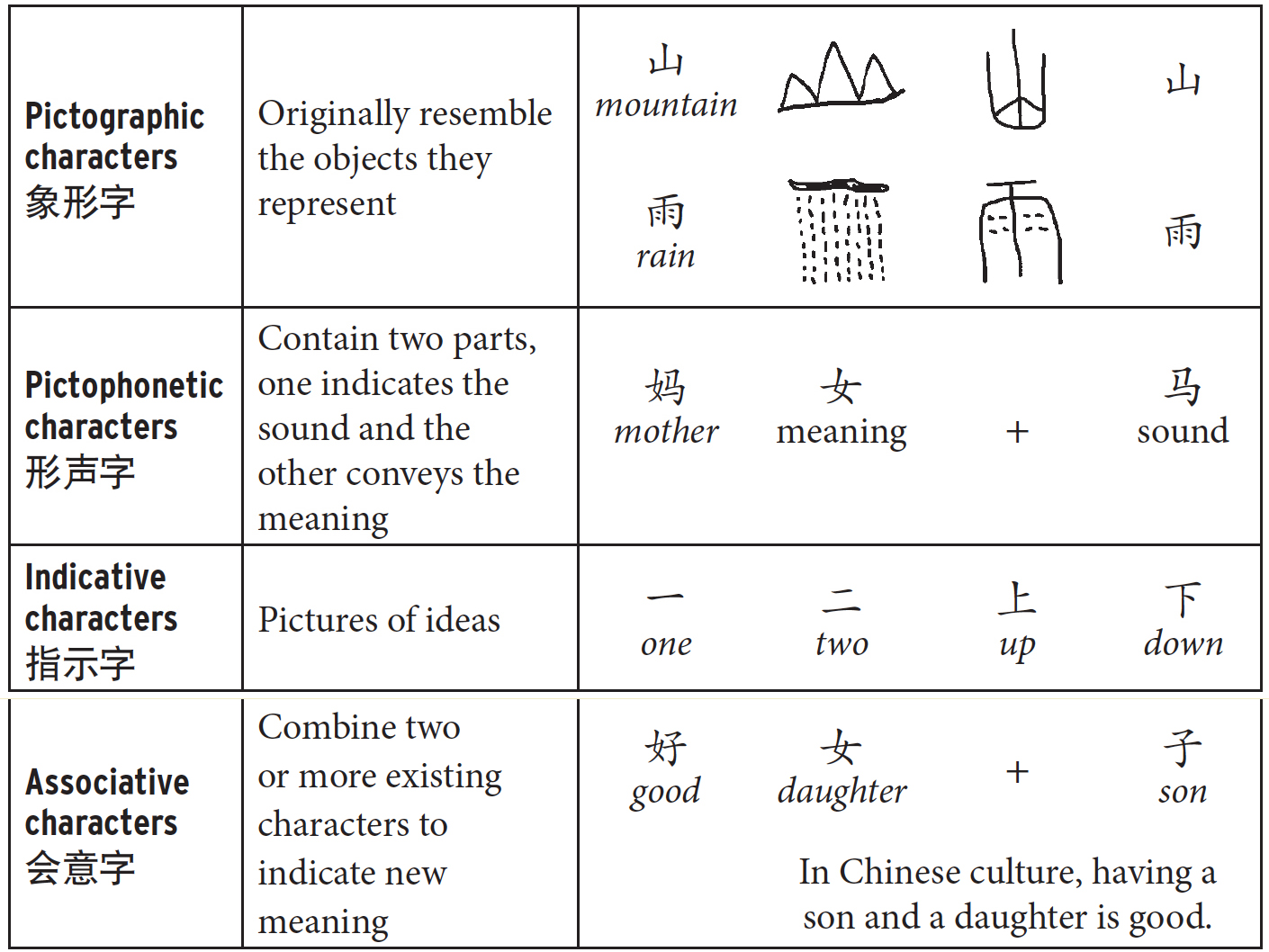 How are characters pronounced? Chinese is not a phonetic language and the romanization of a character usually bears no relation to its written form. This book adopts the Hanyu Pinyin, a special romanization system, created for learners of Chinese to aid pronunciation.
How are characters pronounced? Chinese is not a phonetic language and the romanization of a character usually bears no relation to its written form. This book adopts the Hanyu Pinyin, a special romanization system, created for learners of Chinese to aid pronunciation.
Each Chinese character is pronounced using only one syllable. A syllable consists of an initial consonant, a final vowel, and a tone. Here is an example of the syllable m . 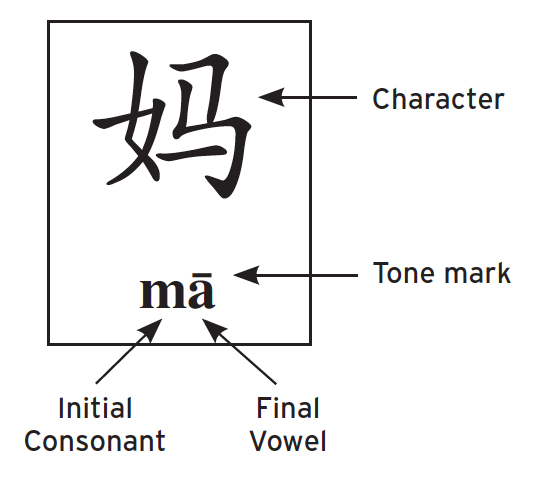 Chinese is a tonal language. Tone matters because a variation in tone implies a change in meaning.
Chinese is a tonal language. Tone matters because a variation in tone implies a change in meaning. 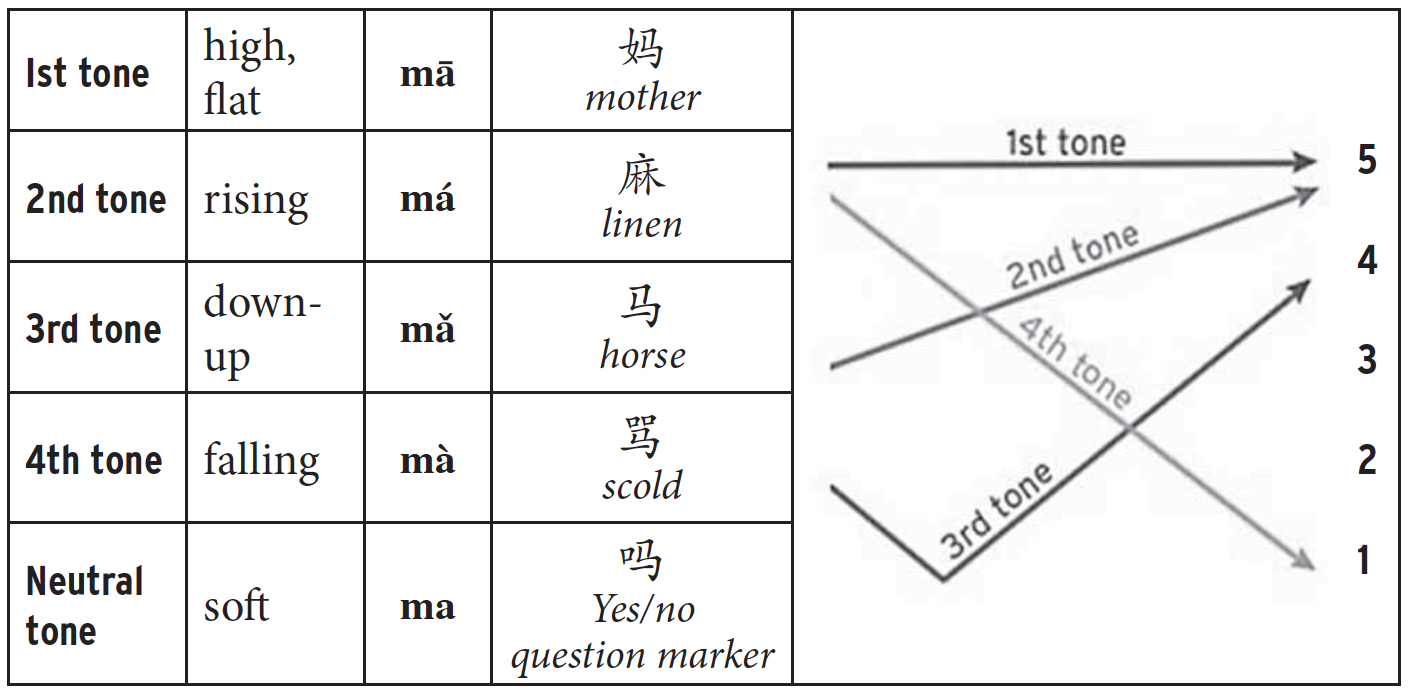 How do I write Chinese characters? Chinese characters are squarish in appearance.
How do I write Chinese characters? Chinese characters are squarish in appearance.  How do I write Chinese characters? Chinese characters are squarish in appearance.
How do I write Chinese characters? Chinese characters are squarish in appearance.
In learning to write the characters try to visualize them as in a box each, and the proper rendering of each stroke should result in a neat character well proportioned and sitting right in the middle of the invisible box.
Basic strokes Each character is composed of a number of basic strokes. Strokes come in various shapes and sizes: a stroke can be a dot, a horizontal line, a vertical line, a diagonal line or a line with a hook. The basic eight strokes are indicated in the character : 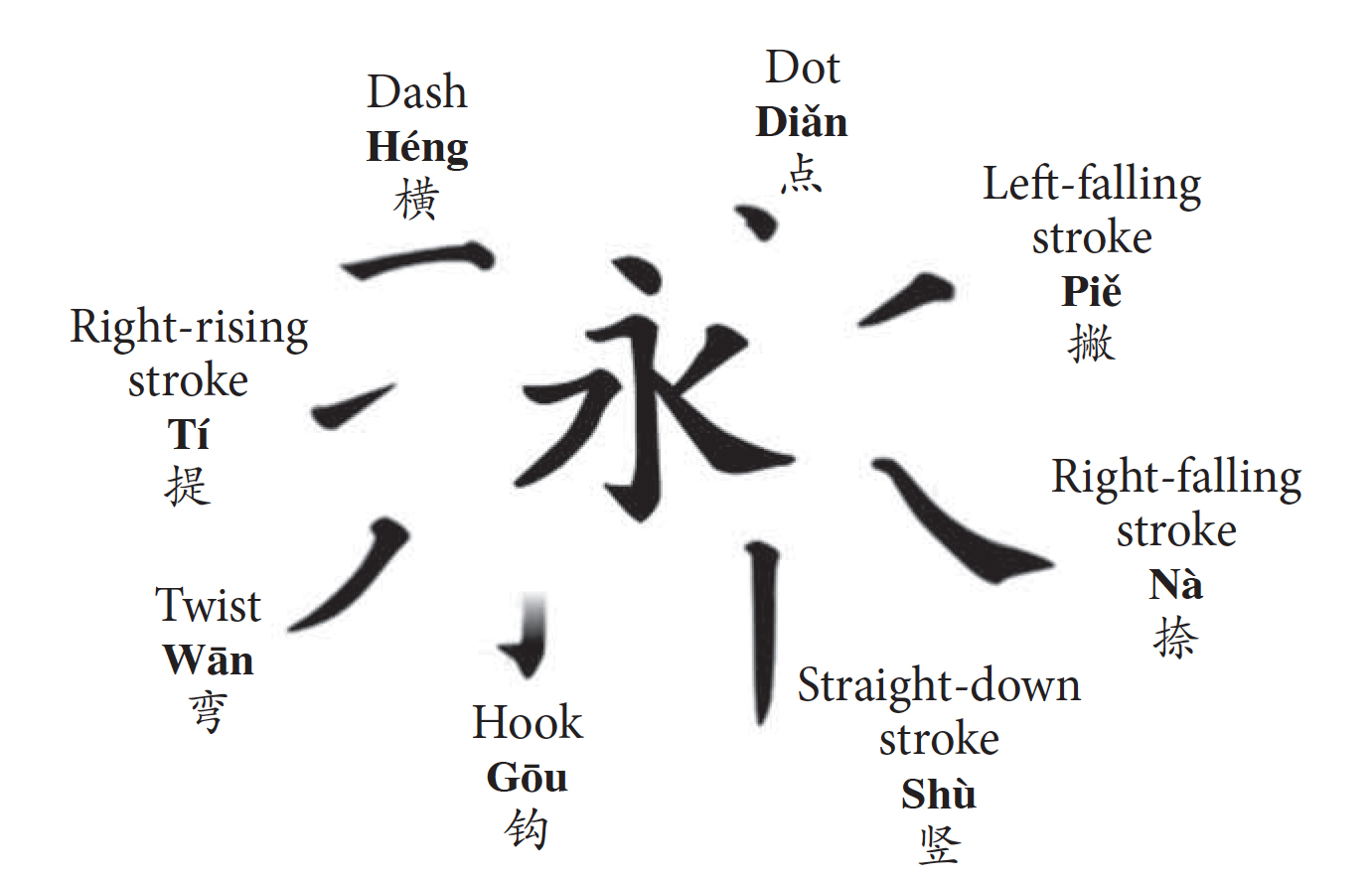 Stre order Writing characters in the correct stroke order is important if the character is to have the correct appearance. To get it right, it is important to remember the 7 rules:
Stre order Writing characters in the correct stroke order is important if the character is to have the correct appearance. To get it right, it is important to remember the 7 rules: 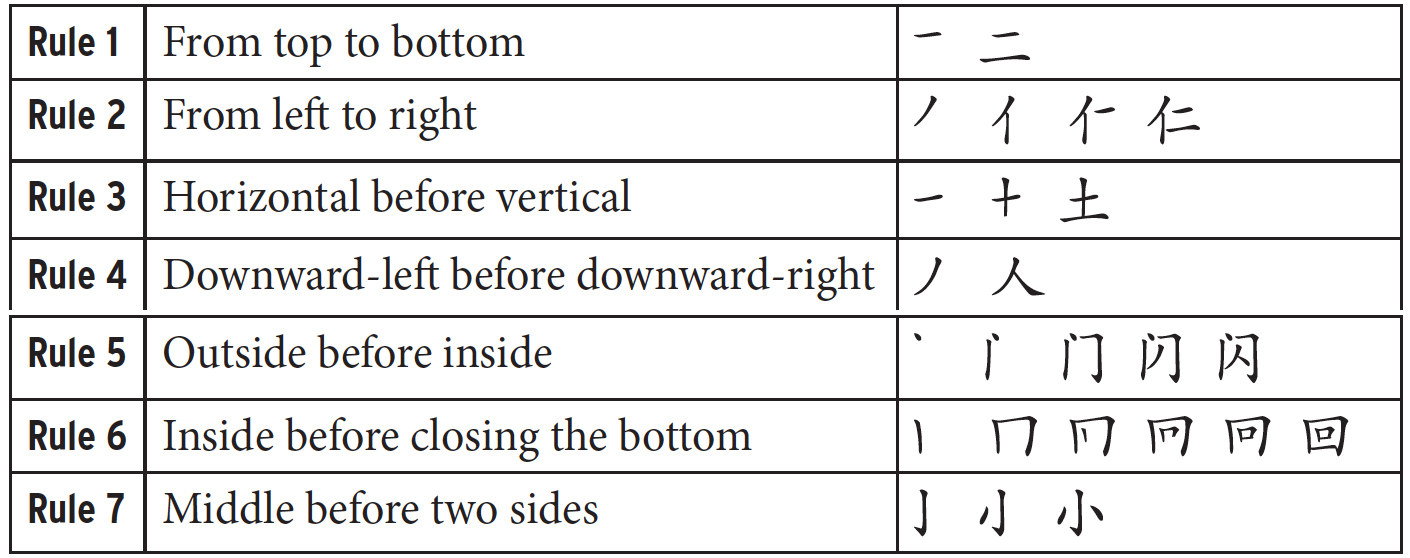 Radicals Every Chinese character has a radical or is itself a radical. There are more than 200 radicals in Chinese. is , which means a person. is , which means a person.
Radicals Every Chinese character has a radical or is itself a radical. There are more than 200 radicals in Chinese. is , which means a person. is , which means a person.
This component is the radical for all the three characters above and it gives a clue to the meaning of the character. Knowing radicals not only helps us to guess the meaning of a character, but it also makes it easy for us to look up the meaning of a character in a dictionary. A radical list is included in the Practice Pad to facilitate your learning of the radicals. What are the main characteristics of Chinese grammar? Word order plays a key role in structuring ideas. The word order of the basic Chinese sentence structure is SubjectVerbObject, which matches that of English (see Example 1). 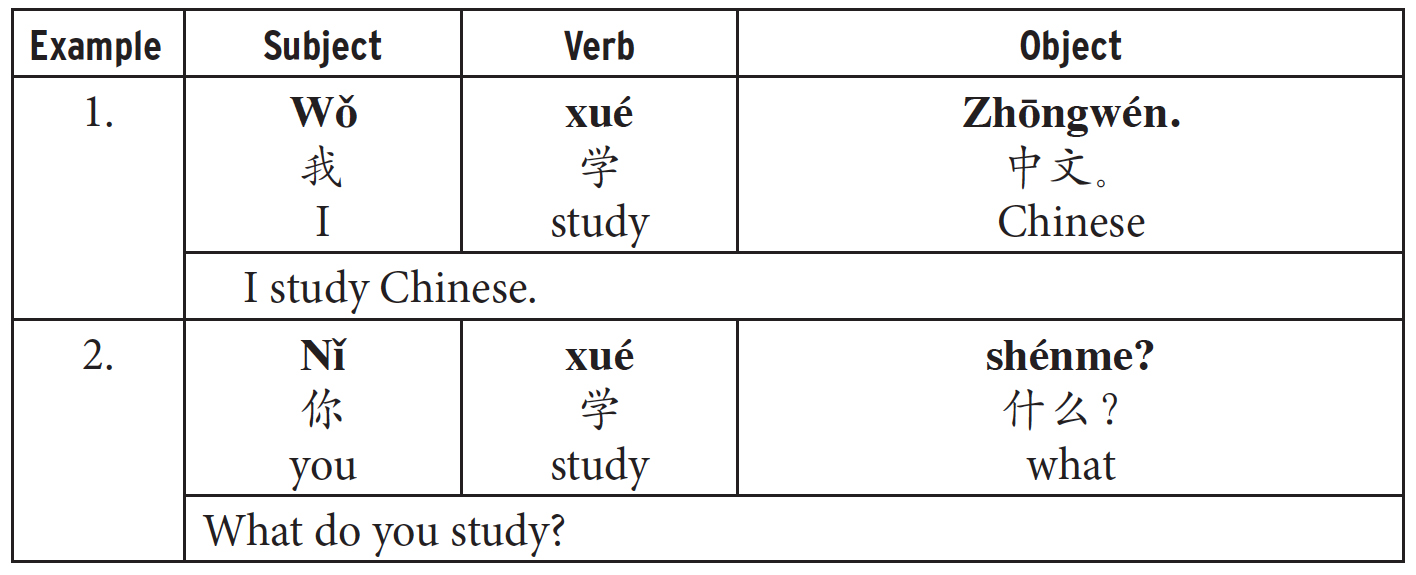 The significance of the word order emerges as we try to add more details to the basic sentence structure.
The significance of the word order emerges as we try to add more details to the basic sentence structure.  The significance of the word order emerges as we try to add more details to the basic sentence structure.
The significance of the word order emerges as we try to add more details to the basic sentence structure.
For example, the notion of place goes before the verb (see Example 3).  If we add a time notion to the above sentence, we can either put Time before Place (see Example 4) or put Time at the beginning of the sentence (see Example 5).
If we add a time notion to the above sentence, we can either put Time before Place (see Example 4) or put Time at the beginning of the sentence (see Example 5). 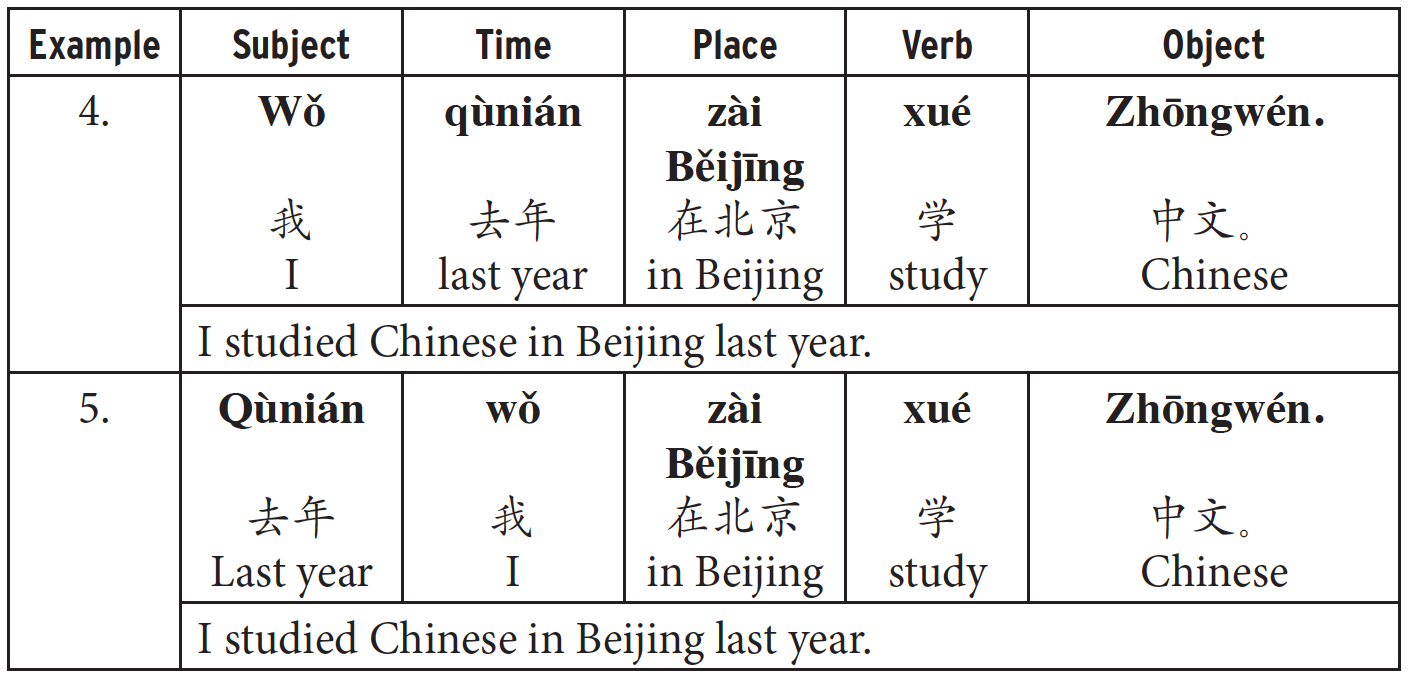 There are always exceptions to the word order, depending on the different grammatical functions and the complexity of the sentence. For beginners, the above basic structures should suffice. Function words () play an important role in a sentence and unlike English, Chinese is not an inflectional language. The verb-form remains unchanged under all circumstances, and function words are added to indicate the subtle changes in meaning.
There are always exceptions to the word order, depending on the different grammatical functions and the complexity of the sentence. For beginners, the above basic structures should suffice. Function words () play an important role in a sentence and unlike English, Chinese is not an inflectional language. The verb-form remains unchanged under all circumstances, and function words are added to indicate the subtle changes in meaning.
Function words serve only grammatical functions and they often carry no meaning by themselves. They appear as adverbs, prepositions, conjunctions and particles, interjections and onomatopoeias. For example, the function word le is used to indicate past action. 
Next page


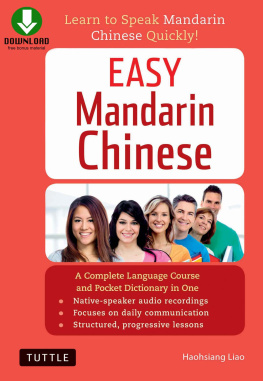
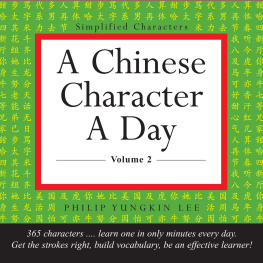
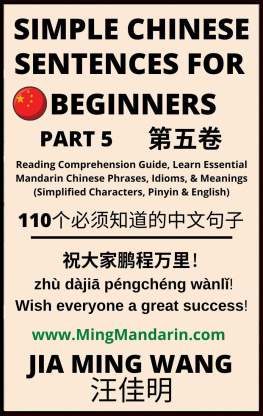
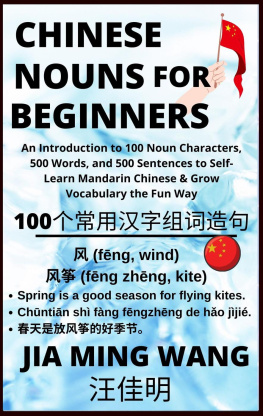
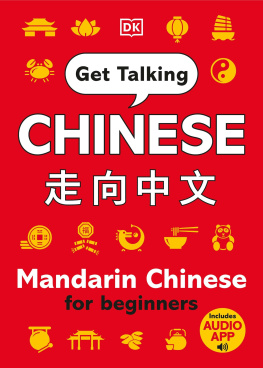
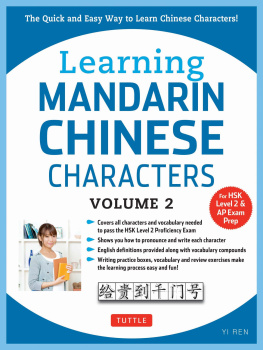
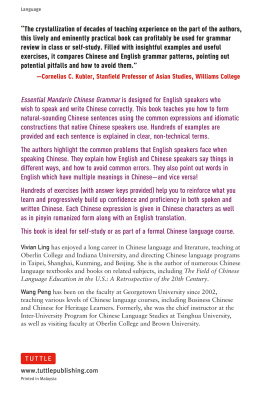
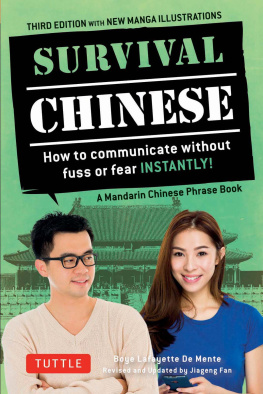
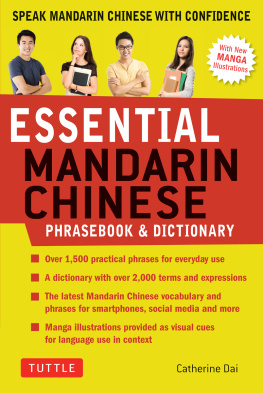
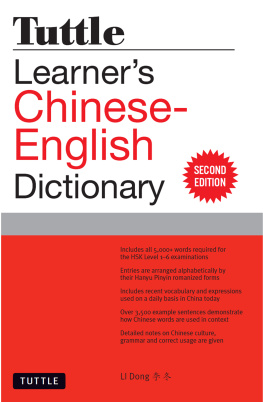

 Published by Tuttle Publishing, an imprint of Periplus Editions (HK) Ltd. www.tuttlepublishing.com Copyright 2017 by Periplus Editions (HK) Ltd All rights reserved. No part of this publication may be reproduced or utilized in any form or by any means, electronic or mechanical, including photocopying, recording, or by any information storage and retrieval system, without prior written permission from the publisher. ISBN 978-0-8048-4649-3; ISBN 978-1-4629-1943-7 (ebook) First edition 20 19 18 17 10 9 8 7 6 5 4 3 2 1 1705CM Printed in China TUTTLE PUBLISHING is a registered trademark of Tuttle Publishing, a division of Periplus Editions (HK) Ltd. Distributed by North America, Latin America & Europe Tuttle Publishing 364 Innovation Drive North Clarendon, VT 05759-9436 U.S.A. Ltd. 61 Tai Seng Avenue #02-12 Singapore 534167 Tel: (65) 6280-1330; Fax: (65) 6280-6290 www.periplus.com ABOUT TUTTLE Books to Span the East and West Our core mission at Tuttle Publishing is to create books which bring people together one page at a time. 61 Tai Seng Avenue #02-12 Singapore 534167 Tel: (65) 6280-1330; Fax: (65) 6280-6290 www.periplus.com ABOUT TUTTLE Books to Span the East and West Our core mission at Tuttle Publishing is to create books which bring people together one page at a time.
Published by Tuttle Publishing, an imprint of Periplus Editions (HK) Ltd. www.tuttlepublishing.com Copyright 2017 by Periplus Editions (HK) Ltd All rights reserved. No part of this publication may be reproduced or utilized in any form or by any means, electronic or mechanical, including photocopying, recording, or by any information storage and retrieval system, without prior written permission from the publisher. ISBN 978-0-8048-4649-3; ISBN 978-1-4629-1943-7 (ebook) First edition 20 19 18 17 10 9 8 7 6 5 4 3 2 1 1705CM Printed in China TUTTLE PUBLISHING is a registered trademark of Tuttle Publishing, a division of Periplus Editions (HK) Ltd. Distributed by North America, Latin America & Europe Tuttle Publishing 364 Innovation Drive North Clarendon, VT 05759-9436 U.S.A. Ltd. 61 Tai Seng Avenue #02-12 Singapore 534167 Tel: (65) 6280-1330; Fax: (65) 6280-6290 www.periplus.com ABOUT TUTTLE Books to Span the East and West Our core mission at Tuttle Publishing is to create books which bring people together one page at a time. 61 Tai Seng Avenue #02-12 Singapore 534167 Tel: (65) 6280-1330; Fax: (65) 6280-6290 www.periplus.com ABOUT TUTTLE Books to Span the East and West Our core mission at Tuttle Publishing is to create books which bring people together one page at a time. How are characters pronounced? Chinese is not a phonetic language and the romanization of a character usually bears no relation to its written form. This book adopts the Hanyu Pinyin, a special romanization system, created for learners of Chinese to aid pronunciation.
How are characters pronounced? Chinese is not a phonetic language and the romanization of a character usually bears no relation to its written form. This book adopts the Hanyu Pinyin, a special romanization system, created for learners of Chinese to aid pronunciation. Chinese is a tonal language. Tone matters because a variation in tone implies a change in meaning.
Chinese is a tonal language. Tone matters because a variation in tone implies a change in meaning.  How do I write Chinese characters? Chinese characters are squarish in appearance.
How do I write Chinese characters? Chinese characters are squarish in appearance.  Stre order Writing characters in the correct stroke order is important if the character is to have the correct appearance. To get it right, it is important to remember the 7 rules:
Stre order Writing characters in the correct stroke order is important if the character is to have the correct appearance. To get it right, it is important to remember the 7 rules:  Radicals Every Chinese character has a radical or is itself a radical. There are more than 200 radicals in Chinese. is , which means a person. is , which means a person.
Radicals Every Chinese character has a radical or is itself a radical. There are more than 200 radicals in Chinese. is , which means a person. is , which means a person. The significance of the word order emerges as we try to add more details to the basic sentence structure.
The significance of the word order emerges as we try to add more details to the basic sentence structure.  If we add a time notion to the above sentence, we can either put Time before Place (see Example 4) or put Time at the beginning of the sentence (see Example 5).
If we add a time notion to the above sentence, we can either put Time before Place (see Example 4) or put Time at the beginning of the sentence (see Example 5).  There are always exceptions to the word order, depending on the different grammatical functions and the complexity of the sentence. For beginners, the above basic structures should suffice. Function words () play an important role in a sentence and unlike English, Chinese is not an inflectional language. The verb-form remains unchanged under all circumstances, and function words are added to indicate the subtle changes in meaning.
There are always exceptions to the word order, depending on the different grammatical functions and the complexity of the sentence. For beginners, the above basic structures should suffice. Function words () play an important role in a sentence and unlike English, Chinese is not an inflectional language. The verb-form remains unchanged under all circumstances, and function words are added to indicate the subtle changes in meaning.